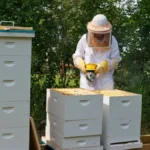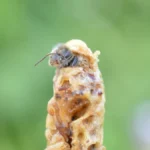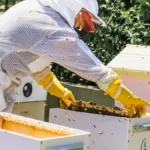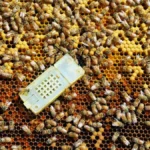In this article, we look at the practice of splitting a hive to prevent swarming. We often are confounded by working out how to stop bees from swarming. A simple swarm control split can stop the loss of swarms. It is also important to know when it is too early or too late to split a hive.
Why Do Bees Swarm?
A beehive is governed by pheromones. The queen pheromone controls the workers, and, if a queen is not able to produce enough queen pheromones, the workers make queen cells. There are two main reasons a queen may not be able to produce enough pheromones to control her hive.
If she has laid a lot of eggs and the beehive population is getting huge, her pheromones may just not be enough for the whole hive. In this case, the bees make queen cells and the old queen leaves with about half the workers as a swarm.
In some races of bees when the queen gets old and worn out the workers will make queen cells and some of the young queens can swarm with a handful of workers. I have seen hives like this spit out up to 10 swarms with virgin queens. This is common in African/Africanised races of bees.

Read more about: How Long Can A Hive Be Queenless?
Certain races of bees are just programmed to swarm in spring. With corrective maintenance, we can trick them into thinking they have swarmed. This article looks at these tricks.
How To Stop Bees From Swarming?
There are a number of management techniques that can be used to stop swarming.
Reduce Brood Nest Size To Reduce Population Growth
In some races of bees, reducing the size of the brood nest can maintain population levels at the right ratio of queen to worker. A queen excluder is used to keep the queen in one or two brood boxes, and this limits the number of workers she can produce.
Re-queening Regularly
Replacing queens regularly ensures that you always have a nice vibrant young queen in the hive. She will have a lot of pheromones. Because she is young, her swarming impulse is low. This in combination with the use of queen excluders for population control can help.
You can replace a queen by killing the existing queen and introducing a queen cell after a day or two. This will hatch in a day or two and inherit the hive. This method will result in a few days of no egg-laying activity. The virgin queen will mate with drones from your area, who may be adapted to the region.
When re-queening with queen cells it is important to open the hive a few days after she has emerged and check that there are no other queen cells in the hive. She should keep these under control and kill them, but some races of bees will take this as an excuse to swarm.
Alternatively, you can remove the old queen and replace her with a new mated queen. This works with European races of bees, and, with practice and a bit of luck sometimes with African races.
If we look at a swarm, however, the reason bees swarm is to reproduce. As beekeepers, more often than not, either ourselves or a beekeeping friend could use a new swarm of bees, so lets rather work with them and help the bees multiply. This is where a swarm control split is useful.
What Is A Swarm Control Split?
If we take a hive when it is building up, and remove some of the bees and brood combs in that hive to a new box we are reducing the population of the parent box. Normally we split into a five-frame nucleus box, or if we have two brood boxes, we can split these into two hives.
With the bees I work with, I find the best method involves splitting a hive when there are 9 frames of brood in the brood box.
The splits then each get half of the brood and a pollen comb with some honey. It is important that both boxes have a pollen and honey frame. Avoid moving too much honey into the split as this can encourage robbing if you have a sudden dearth of nectar caused by a spell of hot spring weather.
It is best to split hives before you have added supers and prepared for a honey flow.
By splitting, you have now turned one hive into two. There was only one queen, so one of the hives will be queen-less.
Placing Your Swarm Control Splits
I have found that in my area I can only get splits to work well in a strong honey flow. In the method I use, I split the hives equally, and then move the mother hive 1 yard to the left and the split hive one yard to the right. The foragers split themselves relatively evenly between the two hives.
Alternatively, move the splits to an apiary at least 3 miles away from the mother hives.
Options For Re-queening The Queen-less Split
Introduce A New Queen
You can introduce a new queen into the queen-less split. It is generally better to do this one to two days after splitting the hives so that they have had time to realize they do not have a queen. You will also be able to see which hive has a queen and which does not. The queen-less hive will have begun making queen cells.
A new queen is normally introduced to the hive in a queen cage with a small hole filled with candy to keep her in. The cage has gauze walls and her pheromones can get through to the workers. By the time they have nibbled through the candy, her pheromones have spread into the hive and they accept her.
It is best to put the queen cage in the center of the brood nest. Place the candy hole upwards and secure the cage with a few rubber bands. The bees will eat the rubber bands in a few days.
The reason it is good to wait two to three days or so before introducing the queen is that in certain races of bees if you introduce the queen immediately after splitting, the pheromones of the old queen are still so strong that the workers can get defensive towards the queen in the cage.
I have seen them nibble the queen’s feet right off through the gauze. A footless queen is of little use to a hive as she uses her feet to measure the cell size and work out whether to lay a drone or worker egg.
Introduce A Queen Cell
Much like introducing a queen, it is better to wait a day or two, and then add one or two queen cells to the hive. If the hive is too freshly split, the workers will sometimes eat the new queen cell. You can also put a queen cell guard around the queen cell. I feel that these sometimes damage the queen cell.
Allow The Bees To Rear New Queen Cells
If you make sure that both splits have freshly laid eggs in them, the split that does not have a queen will raise queen cells.
This is a relatively inefficient way to make a split. The hive does not have a queen to lay eggs. The means they will miss out on nearly three weeks of egg-laying activity while the new queen is reared, and then goes on her mating flights. At 2000 eggs a day, that is a lot of bees.
In my opinion, from experience, I have had the best success with making splits and introducing queen cells which are three days from hatching. The other methods seem to have a lower success rate.
When Is It Too Late To Split A Hive?
If you split a hive after they have swarmed you have basically missed the point of the split and lost half of your bees.
All is not lost, however, and normally near every apiary I have, I place a couple of old beehives on a roof, or in trees and you will often find that you will catch the swarms which leave if there is a strong honey flow on the go.
We hope you have enjoyed this article and share it with a friend who also wants to keep bees. You never know, maybe if they don’t really get the stuff in this article right, your hive on a roof will catch their swarm.
Read more about: Protecting Beehives From Bears

Dr. Garth A. Cambray is a Canadian/South African entrepreneur and beekeeper with 28 years of experience in apiculture and specializes in adding value to honey. His Ph.D. research developed a new advanced continuous fermentation method for making mead that has resulted in a number of companies globally being able to access markets for mead. His company, Makana Meadery, exports honey mead to the USA where it is available to discerning connoisseurs. He has also developed technologies to commercially manufacture organic honey vinegar in Zambia for export globally. He holds a few patents globally in the ethanol industry and believes in technology and knowledge transfer for human development and environmental sustainability. One of his proudest achievements is the fact that the wind farm he started at one of his old apiary sites has essentially made his hometown carbon neutral.






